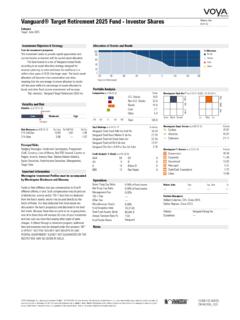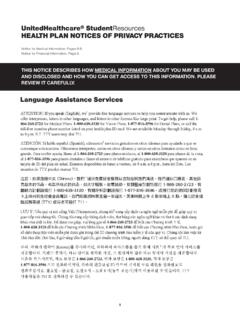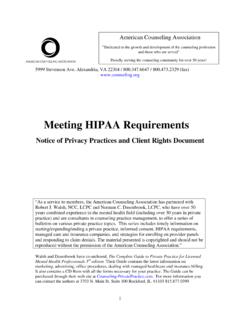Transcription of Nestlé 401(k) Savings Plan and the Nestlé USA, Inc. Hourly ...
1 Nestl 401(k) Savings Plan and the Nestl USA, Inc. Hourly Retirement Savings Plan (each referred to as Savings Plan ) - Important Information Regarding Your Right to Defer Distributions For Payments Not From A Designated Roth Account As a participant in the Savings Plan, you will need to make a decision about what to do with your retirement Savings in the Savings Plan upon you separation of employment. this notice , provided in accordance with federal tax laws, is intended to describe the tax consequences of distributions from the Savings Plan of amounts that are not from a designated Roth account (a type of account with special tax rules in some employer plans), including the consequences of not delaying payment of your benefit.
2 A separate notice describes the tax consequences of a distribution from a designated Roth account under the Savings Plan, including the consequences of not delaying payment of your benefit. While you are permitted to take a distribution of part or all of your account upon separation of employment, did you know that if you are under age 72, you may elect to leave your account in the Savings Plan and continue to direct the investment of your account from among the available investment options? this will allow you to defer federal income tax, will allow any investment earnings on your account to continue to grow tax-free, and may result in a lower rate of income tax when you ultimately take a distribution from your Savings Plan account.
3 If you decide to take a distribution from the Savings Plan upon separation of employment, any amount you receive will generally be included in your taxable income, unless it is a lump sum distribution that you roll over to a traditional IRA or another eligible plan. If you do not roll your lump sum distribution directly over to an IRA or another eligible plan, the entire amount (other than any after-tax contributions, including Roth 401(k) amounts and earnings on those amounts) will be subject to 20% income tax withholding. It may also be subject to an additional 10% penalty tax if you receive the distribution before age 59.
4 If you decide to keep your money in the Savings Plan, you must begin taking required minimum distributions beginning April 1 of the year following the year you reach 72 or retire, whichever is later. this rule may not apply to you if you reached age 70 before December 31, 2019. If that is the case, you must begin taking required minimum distributions beginning April 1 of the year following the year you reached age 70 . The Special Tax notice below describes in more detail the consequences of taking a distribution or rolling it into an IRA. or another qualified plan. If you elect to defer distribution of your Savings Plan account, information regarding the investment options available to you, including descriptions of the investment objectives and a summary of the fees for the different investment options, can be found in the Smart$aving Guide, Self-Directed Brokerage Account Fact Sheet, Investment Fund Fact Sheets, and Investment Summary.
5 this information may also be found on the Nestl Smart$aving website ( ) or you may request it by calling the Nestl Smart$aving Call Center at 1-877-NesCALL (1-877-637-2255) and selecting the 401(k) Savings prompt. The Summary Plan Description ( SPD ) provides further information regarding Savings Plan benefits. We encourage you to refer to your Savings Plan's SPD for Savings Plan rules that may affect your decision regarding when to process a distribution from the Savings Plan. The SPD is available on the Nestl Smart$aving website or by calling the Nestl Smart$aving Call Center.
6 How to obtain additional information For more information regarding Savings Plan rules or your distribution, contact the Nestl Smart$aving Call Center. Special Tax notice ( notice ) Regarding Plan Payments- Your Rollover Options this notice is provided to you by Nestl USA, Inc. (your Plan Administrator ) because all or a portion of a payment you may receive from the Savings Plan may be eligible to be rolled over to an IRA or an employer plan. this notice is intended to help you decide whether to do such a rollover. this notice describes the rollover rules that apply to payments from the Savings Plan that are not from a designated Roth account (a type of account with special tax rules in some employer plans).
7 If you also receive a payment from a designated Roth account in the Savings Plan, you will be provided a different notice for that payment, and the Plan Administrator will tell you the amount that is being paid from each account. Rules that apply to most payments from a plan are described in the General Information About Rollovers section. Special rules that only apply in certain circumstances are described in the Special Rules and Options section. this notice is based on a format prepared by the Internal Revenue Service. Although the Plan Administrator hopes that you find this information helpful, neither the Plan Administrator, nor the trustee, nor any other person related to them can provide tax advice or make any representations regarding the tax consequences with respect to rollovers or distributions of your Savings Plan benefit.
8 Your right to waive the 30-day notice period Generally, neither a direct rollover nor a payment can be made from the Savings Plan until at least 30 days after you receive this notice . Thus, after receiving this notice , you have at least 30 days to consider whether or not to have your distribution directly rolled over. If you do not wish to wait until the full 30-day notice period ends before your election is processed, you may waive the notice period by making an affirmative election indicating whether you would like your payment made in a direct rollover or directly to you. Your distribution election will then be processed as soon as practical after it is received by the Plan Administrator.
9 GENERAL INFORMATION ABOUT ROLLOVERS. How can a rollover affect my taxes? You will be taxed on a payment from the Savings Plan if you do not roll it over. If you are under age 59 and do not do a rollover, you will also have to pay a 10% additional income tax on early distributions (generally, distributions made before age 59-1/2), unless an exception 1. applies). However, if you do a rollover, you will not have to pay tax until you receive payments later and the 10% additional income tax will not apply if those payments are made after you are age 59 (or if an exception applies).
10 What types of retirement accounts and plans may accept my rollover? You may roll over the payment to either an IRA (an individual retirement account or individual retirement annuity) or an employer plan (a tax-qualified plan, section 403(b) plan, or governmental section 457(b) plan) that will accept the rollover. The rules of the IRA or employer plan that holds the rollover will determine your investment options, fees, and rights to payment from the IRA or employer plan (for example, no spousal consent rules apply to IRAs and IRAs may not provide loans). Further, the amount rolled over will become subject to the tax rules that apply to the IRA or employer plan.















